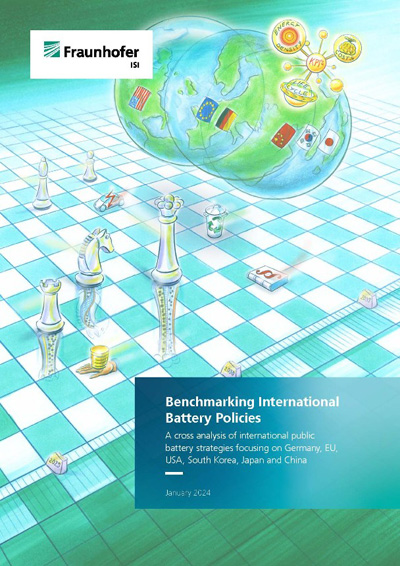nternational battery policies: What are the strategies of the leading countries?
Countries worldwide are renewing or adapting their political strategies for battery technologies.
In this context, a new Fraunhofer ISI report is analysing the different battery policies and targets with focus on three fields of battery technology research: Lithium-ion, solid-state, and alternative batteries. The report highlights the political goals and strategies of the following countries: Japan, South Korea, China, the U.S., Europe and within it Germany.
Europe needs to take a decisive step in the transition toward decarbonized sectors such as energy and transport. In this context, a European battery ecosystem with scaled production and circular supply chains can help achieving this goal. These transitions, however, are now being driven by international crises and traditional alliances have become more fragile, so the role of access to critical technologies has returned to centre stage. These and other aspects have to be considered when establishing a battery ecosystem which is the case in many countries such as Germany and the whole EU.
In this context, an international comparison between the different battery policy strategies of the leading countries is helpful – and now part of a new Fraunhofer ISI study entitled »Benchmarking International Battery Policies«. The report focuses on lithium-ion, solid-state, and alternative batteries, and the political goals and strategies of Japan, South Korea, China, the U.S. and Europe. The study authors analysed national announcements, publications and roadmaps describing political and technical objectives, key performance indicators and funding strategies set across the mentioned countries.
The funding of battery research has grown worldwide
The findings show that all countries have specific goals to become less dependent on international supply chains, regarding the electrification of mobility and the upscaling of production capacities for advanced battery technologies. Climate neutrality by 2045 (Germany) or 2050 is another common goal, with the exception of China (2060), but specific objectives regarding sustainability and recycling of batteries greatly vary. It also became clear that all countries have strengthened their public R&D funding since 2014 and many of them have experienced a rapid expansion, especially since 2020, due to new strategies (U.S.: Bipartisan Infrastructure Act, Japan: Green Growth Strategy, Korea: Secondary Battery Innovation Strategy) and strategic programs (Germany: Roof Concept of Battery Research in 2023). The funding has doubled or even tripled for the countries compared to the level of funding before 2020.
A cross-country analysis within the study on key performance indicators such as gravimetric and volumetric energy density, cycle life or costs revealed that each country uses a different number of KPIs with different degrees of feasibility: Some of the countries use many KPIs, for example China for liquid electrolyte-based lithium-ion, solid-state and alternative batteries, others such as South Korea focus on a smaller number of core KPIs for special technologies like solid-state, lithium-sulfur and lithium-metal batteries. In some cases, KPIs are defined as the goals to be achieved through specific public funding programs (e.g. U.S. energy density target of 500 Wh/kg for the DOE-funded Battery500 consortium) or in other cases, are applied to next generation technologies with still uncertain development potentials (e.g. Japan has performance goals for commercialization of zinc-anode/fluoride-shuttle batteries beyond 2030).
Having a separate look at each country, the study shows the following facts:
– China for a long time has massively relied on demand-side policies and focused on its huge domestic market for electric vehicles, but is now shifting more toward a targeted battery strategy with increasing supply-side measures. As of 2022, China has the largest market share in the battery industry and is trying to strengthen its global market position. For a long time, China had focused on performance parameters such as energy density, but is now increasingly including qualitative parameters such as safety. The government has very specific goals about sustainability, for example with regard to positioning in the EU market. China is currently focusing on lithium-ion, solid-state, metal-sulfur, and especially Li-sulfur batteries.
– Germany has historically pursued an open technology strategy for battery technology with many different measures, but the »Battery Research Roof Concept« updated in January 2023 newly introduced a specific strategy on performance parameters. This concept also focuses on the development of production processes at larger scales to address the lack of production capacity. Also, project activities and funding together with the European industry are aiming at aligning with the EU policy on cross-cutting issues such as sustainability, recycling and digitalization of batteries. On the technological side, the German strategy has defined specific targets for the development of solid-state, sodium-ion and other alternative batteries.
– Japan as an early technology leader has traditionally focused on the supply side. However, as the country recognized that it was steadily losing ground in market competition and that the era of lithium-ion batteries will continue for the time being, the priority has recently been given to increasing production capacity and ensuring the domestic and global market in lithium-ion batteries, for example within a Battery Industry Strategy formulated in 2022. With regard to the technology, Japan is focusing on lithium-ion, solid-state, and alternative battery types such as fluoride shuttle and zinc-anode batteries and is the only country with KPIs for alternative battery prototypes by 2025.
– The United States have invested – also trough programs such as the recent Inflation Reduction Act 2022 – in both supply- and demand-side policies in a well-balanced way. As for innovation policies, the country has taken rather a technology-open strategy with the target to become the international leader in R&D and get more independence from competitors, especially China. In this context, the newly published national blueprint also sets performance parameters for the cost and sustainability of batteries. Future »revolutionary battery technologies« include solid-state and Li-metal batteries for example, but the U.S. also focus on Lithium-ion and Li-metal batteries with liquid electrolyte and the supply of the domestic market.
– South Korea aims for international leadership regarding its battery industry. The countries’ strategy shows a clear R&D focus on commercializing lithium-sulfur (2025), solid-state (2027) and lithium-metal batteries (2028). South Korea has supported not only the promotion of its EV-industry, but also provided direct support for its battery manufacturers, for example by giving large tax credits. As a unique feature of the national strategy, three large private companies are going to invest massively together with the government. The country is focusing on lithium-ion, solid-state, and next-generation batteries, but Li-sulfur and Li-metal batteries are also mentioned as alternative battery types.
– The EU’soverall battery policy can be described as supply sided, but includes some demand-side elements regarding the end of the value chain with respect to Electric Vehicle purchasing. Since the EU’s main priority is tackling environmental problems, there are ambitious goals for the sustainability and recycling of batteries that also have been included in the new EU Batteries Regulation. The continent’s focus is on lithium-ion, solid-state and alternative battery types such as redox-flow, metal-air and sodium-ion batteries and the main goal is becoming a leading supplier of sustainable battery technologies in order to establish a competitive and sustainable battery value chain in the EU.
All analysed countries have relatively up-to-date strategies for their battery ecosystems
Project leader at Fraunhofer ISI, Dr. Axel Thielmann, states: »Our study shows that all countries have relatively up-to-date strategies due to the approaching critical phase of market ramp-up and diffusion of electric mobility between 2020 and 2030, the current geo-political situations and the attempts to maintain or achieve technology sovereignty. We also see that strategies are becoming more market and industry oriented and increasingly combine supply and demand side measures for the development of circular battery ecosystems.«
According to the authors, there is not the one right way to support technology development, which is shown by the success of China: The country has built a robust, internationally competitive battery value chain including a leadership in battery R&D. Future policy strategies should rely more on key performance indicators and their monitoring of the status quo. It would also be beneficial to clarify how they can be integrated in current R&D activities to identify progress towards commercialization of optimized Li-ion as well as alternative batteries and how to better align funding measures.
- Benchmarking-International-Battery-Policies_2024.pdf [ PDF 5.97 MB ]
- Battery research at Fraunhofer ISI
Source
Fraunhofer Institute for Systems and Innovation Research ISI 2024









